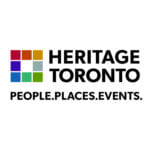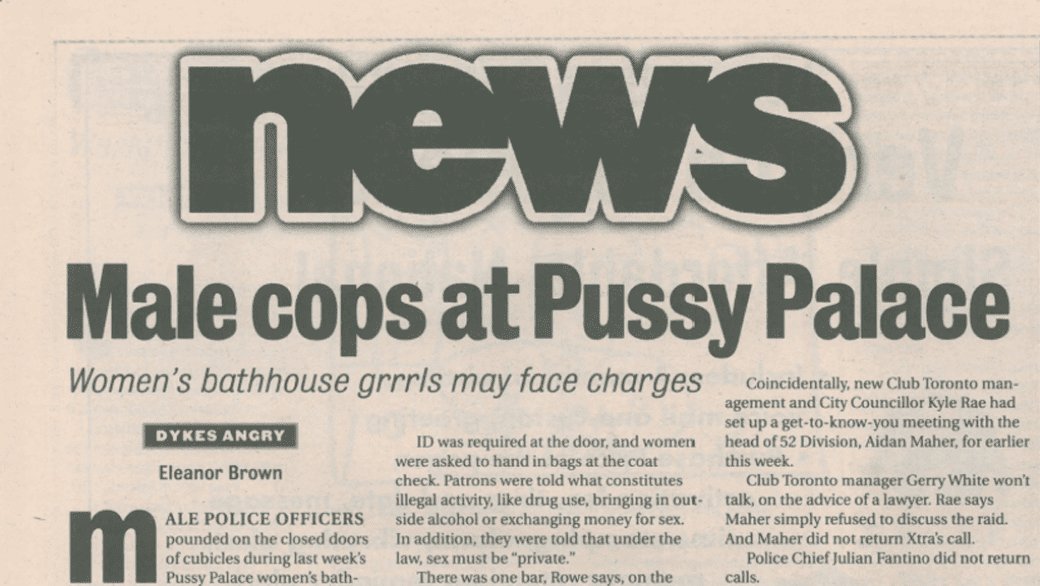This story was created by Xtra's branded content team alongside Heritage Toronto, separate from Xtra's editorial staff.
There are a lot of things to love about Toronto, but one of the greatest things about the city is its rich and storied history. And that’s especially true for the queer women who called Toronto home. In fact, much of Toronto’s LGBT culture is owed to strong, outrageous and brassy women who stood up, made their voices heard and challenged the status quo for what they believed in.
This summer, Heritage Toronto is proud to partner with the Canadian Lesbian and Gay Archives to share some of the important stories of queer women in this city in a series of informative walking tours. In the meantime, here are three ways in which queer women left a mark not only on Toronto’s LGBT history, but the city’s culture entirely.
The Brunswick House Four
Standing at the corner of Brunswick Avenue and Bloor Street West, the recently shuttered Brunswick House began serving up pints to Torontonians in 1876. On Jan 5, 1974, the popular drinking spot, known as a staple to Toronto’s student population, was famously the site of what was described as a lesbian riot.

(L-R) Adrienne Potts, Pat Murphy, Sue Wells and Heather Byers were accused of instigating a “lesbian riot” in 1974 in the Toronto pub Brunswick House. Archive photo
During the bar’s amateur night, a group of four lesbians took to the stage and sang a parody of Rodgers and Hammerstein’s “I Enjoy Being a Girl,” re-titled “I Enjoy Being a Dyke.” This attracted the attention of management, who asked the women to leave. Sue Wells, Adrienne Potts, Pat Murphy and Heather Elizabeth Beyer refused to be pushed out. They were dragged from the bar by police and loaded into police vans. On the way to the police station, several of the women were injured and verbally harassed by the police.
After being forcibly ejected from the police station, the women returned to Brunswick House to obtain witness statements, but were met with further harassment by bar staff and police. Potts, Murphy and Beyer were arrested for creating a disturbance, held in jail and harassed by the duty constables. Potts was eventually sentenced to three months’ probation; the other women were acquitted or had their charges dropped.
According to historian Tom Warner in Never Going Back: A History of Queer Activism in Canada, the Brunswick Four’s courageous resistance to police violence was indicative of a “hardening resolve to fight back” in the early years of LGBT activism in Canada.
The Lesbian Organization of Toronto (LOOT)
In the early 1970s, LGBT activism in Canada was dominated by gay men. The opening of The Lesbian Organization of Toronto in 1976 at 342 Jarvis St helped give lesbians a space of their own as the gay rights movement gained momentum. The centre was started by a group of queer women — two of them were members of the Brunswick Four.
LOOT became a driving force in creating safe spaces for lesbians. The centre hosted a drop-in service, a library, a phone service and published a newsletter. Also important to LOOT were its “coming out” open houses, where women could meet each other outside of the bars. The organization was not without controversy; in 1978, a trans woman applied to join the organization, but was prevented from joining, as LOOT voted for a “womyn-born womyn” policy and put out a public transphobic statement to that regard.
By the end of the 1970s, the organization began to fracture, as various political movements within the organization began to take on lives of their own. By 1980, LOOT had disbanded and the doors to 342 Jarvis St were shuttered. Nonetheless, LOOT left a lasting impact on Toronto’s LGBT scene in 1979 by hosting the first bi-national lesbian conference in Canada, attended by over 400 women.
This short documentary explores the formation and impact of the Lesbian Organisation of Toronto (LOOT) as part of the Queerstory Project. (Queerstory.ca)
Pussy Palace Raid
On Sept 14, 2000, nearly 20 years after the infamous Operation Soap bathhouse raids, the Toronto Women’s Bathhouse Committee (TWBC), an organization that creates sex-positive spaces for women and trans folk, booked the old Club Toronto at 231 Mutual St (currently the Oasis Aqualounge). For one night only, the former gay men’s bathhouse was transformed into the Pussy Palace, an inclusive playspace created for and by queer women.
On the morning of Sept 15, two undercover female police officers infiltrated the Pussy Palace; it was later raided by five male police officers. Police charged JP Hornick and Rachel Aitcheson with offenses against the Liquor License Act, which were eventually thrown out in court. Reflecting on the raid five years later, JP Hornick wrote in Daily Xtra that “the Pussy Palace raid was quite simply an attempt to control queer space and sexuality. It should never have happened.”
One result of the raid was the formation of the Toronto Police LGBT Consultative Committee, which developed a public awareness campaign called “Report Homophobic Violence, Period.” This campaign has been used as a template for many police organizations across the country.
In 2001,TWBC members Carlyle Jensen, Carol Thames, Chanelle Gallant, JP Hornick, Janet Rowe and Loralee Gillis were chosen to lead the Toronto Dyke March.
To learn more about Toronto’s queer history, join Heritage Toronto and the Canadian Gay & Lesbian Archives for Pride Walks: Discovering Toronto’s LGBTQ Heritage.
Part 1 (Church-Wellesley Village) will be held on Saturday, June 18, 2016, while Part 2 (King, Queen and Yonge Streets) will be held on Saturday, June 25, 2016. For more information or to register for these tours, visit heritagetoronto.org/tag/pride/


 Why you can trust Xtra
Why you can trust Xtra